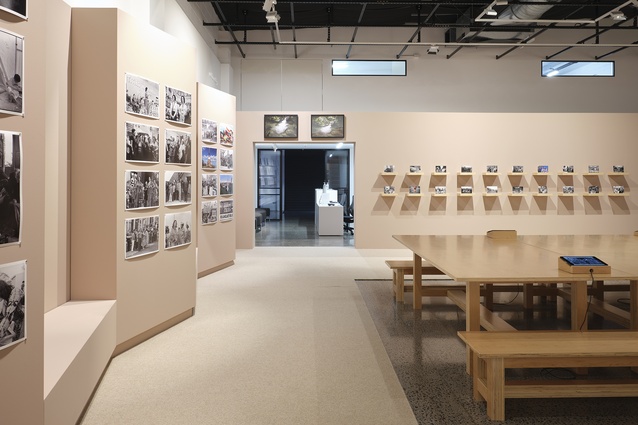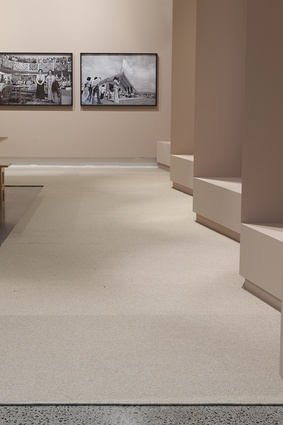Review: Pouwātū: Active Presence
Paul Simei-Barton looks at this collaboration from photographer John Miller and architectural designer Elisapeta Heta, which ran at Objectspace from 9 March to 30 May 2021.
With the world drowning under an avalanche of disposable images, it is increasingly difficult to conceive of a space where photographs might speak to us and slowly reveal their stories. A remarkable collaboration between photographer John Miller and architectural designer Elisapeta Heta offers a solution and presents a cogent challenge to the ephemeral status photographs have acquired in the age of social media.
Originally commissioned for the 2020 Sydney Biennale, the show is brought to home soil as part of Auckland Arts Festival Te Ahurei Toi o Tāmaki. Drawing on her deep understanding of te ao Māori, Elisapeta Heta has reconfigured the main gallery at Objectspace, making it resonate with the essence of a wharenui. The transformation makes particular reference to Te Tai Tokerau wharenui, which often reserve an honoured space for the display of photographs of the dead. By translating this tradition into a gallery context, the exhibition acknowledges the mana of the people represented in the photos and invites the audience to view the images with a measure of reverence.
Invoking the sacred, which is reinforced by a discreet request to remove footwear before entering the gallery, disrupts the predominately secular ethos of contemporary art and calls to mind what Roland Barthes describes as photography’s terrible power to bring about the ‘return of the dead’. It is a quality we take for granted and it has been greatly diminished by the overwhelming ubiquity of digital imagery; however, Pouwātū: Active Presence offers a timely reminder that there are still places where the mana of a photograph is recognised and respected.
In a similar way, the exhibition design reconstitutes the gallery space as a site for conversation, listening and learning. Working against expectations of the gallery as a space to move through, the show repeatedly urges viewers to sit down. Angled seats link a series of pou-like structures where the photos are thematically grouped and the display is centred around a large, artfully constructed table with wooden benches, beckoning visitors to come together and enter into a deeper engagement with the images. The call to conversation is persuasively echoed in the photos themselves, especially the series from Māori Artists and Writers Association hui, with beautifully composed images of informal clusters of attentive listeners gathering around speakers whose passion is eloquently signified in hand gestures.

John Miller is extremely well suited to fulfilling the promise of the exhibition design. With none of the reticence of artists who insist their art speaks for itself, he is always willing to give a fulsome account of the stories which stand behind his commitment, over four decades, to record aspects of the Māori world. His conversation, informed by a prodigious memory for the events and personalities depicted in his work, is abundantly loquacious and wildly digressive.
The photographs cast a revealing light on several aspects of te ao Māori and testify to John Miller’s intimate connection to the community he is documenting. There are celebratory images of the Rātana movement and Māori Women’s Welfare League but the main emphasis is on the long, ongoing history of Māori protest, which has played such a crucial role in defining who we are as a nation. Many of the events recorded are familiar from newspaper and television reportage but the photos are unique in offering the personal viewpoint of a participant rather than an observer. The images take us behind the scenes, bringing us inside the vans, buses, tents, makeshift dwellings and marae where the protest movement forged the solidarity and commitment needed to maintain its public face.
There is an intense lyricism to Miller’s vision as he responds to the fluid geometry of marchers stretched out along rural roads; the striking contrast of red and black flags set against the cool blue of a cloud-flecked sky; the play of light raking across a jumble of baggage and mattresses in a dimly lit wharenui; and, most movingly, the highly animated faces of the protest participants.
The photographs on the walls form a tiny fragment of Miller’s work and touchscreens set in the central table offer a tantalising glimpse of a vast archive of photos standing behind the selected work. A taonga of this kind demands an appropriate setting and Elisapeta Heta has created ideal conditions for delving into the rich storehouse of knowledge contained in these precious photographs.











